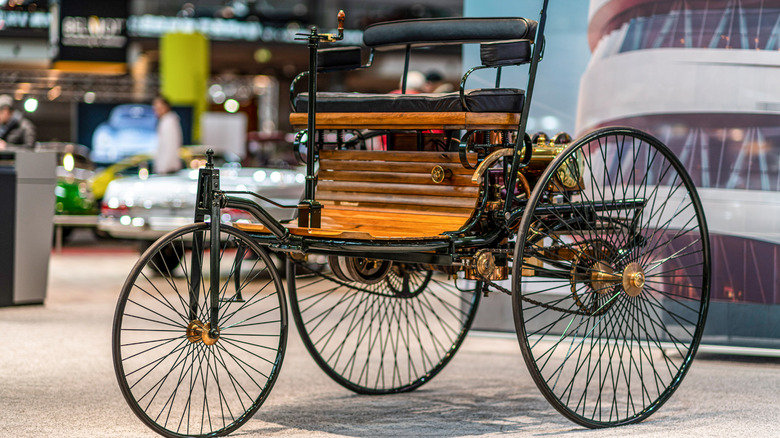The World's First Three-Wheeled Car Looked Even Dorkier Than Today's
Three-wheeled cars are not for everyone. While some people love their captivating "Is it a car, or is it a motorcycle?" vibe, others simply are too trepidatious about their safety and often unorthodox appearance. For the unabashed gearhead, though, the Polaris Slingshot and Morgan's 3 Wheeler are two of the coolest tricycles on the street today. But let's face it, many iterations over the years — like the BMW Isetta, Peel P50, Allard Clipper, and BSA Ladybird — are, as the old saying goes, something only a mother could love.
These conveyances are not new. In fact, the world's very first self-propelled vehicle was a three-wheeler, albeit in this case, a tractor. In 1769, French military engineer and inventor Nicolas-Joseph Cugnot built a vehicle powered by a two-piston steam engine to haul around heavy artillery cannons. The steam boiler was attached to and powered by a single front wheel, which acted as the steering mechanism. Hilariously, Cugnot was also involved in the first vehicle collision when he ran the tractor into a stone wall and was convicted for driving dangerously.
It's understandable why early inventors and even today's more modern automakers would build something with only three wheels. One less wheel removes a lot of additional moving parts, making it far cheaper and easier to build. That later reason seemed most important for Karl Benz when, 117 years after Cugnot's tractor, he created the Benz Patent Motor Car, the world's first production automobile in 1866. It, too, only had three wheels but looked nothing like nothing like today's three-wheelers.
The three-wheeled Benz Patent Motor Car started the automobile revolution
The Benz Patent-Motor Car (also called a Motorwagen) was powered by a single-cylinder four-stroke engine with just 0.75 hp and a maximum top speed of 10 mph that sat horizontally at the back of the chassis behind a two-person seat. It included some very advanced (for the time) features, such as a high-voltage electric ignition with spark plug, water/thermo siphon evaporation cooling, a controlled exhaust valve, and an automatic intake slide.
It wasn't big on aesthetics. In fact, its appearance wasn't much different than the horse-drawn carriages of the day, but the large rear-wired wheels (later replaced by wooden ones for the production model) made it stand out from the standard horse and buggy. To be fair, Benz was working with what was available to him, and getting the gasoline-powered contraption to move on its own was his primary focus.
The Motorwagen drove under its own power for the first time on New Year's Eve of 1879, but wasn't patented (#37435) as a "vehicle with gas engine drive" until January 29, 1886, and is widely considered to be the world's first true automobile. That very same year, Gottlieb Daimler (in Cannstatt near Stuttgart), along with Wilhelm Maybach — another name that should be familiar to gearheads — had developed a four-stroke engine and installed it into a carriage to create the first four-wheeled automobile. Over the next seven years (between 1886 and 1893), Benz sold 25 of his trikes, which was considered something of a success at the time.

